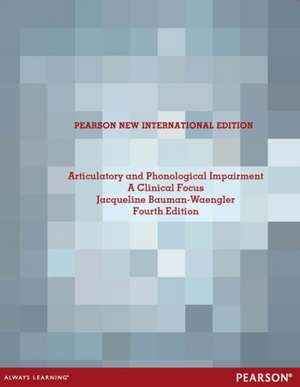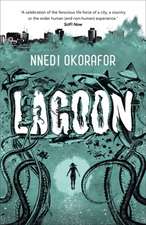Articulatory and Phonological Impairments: A Clinical Focus
Autor Jacqueline Bauman-Waengleren Limba Engleză Paperback – noi 2013
This text offers comprehensive coverage of a wide range of concepts related to articulation and phonology. The text's strong, clinical emphasis along with the variety of helpful learning aids makes this text ideal for understanding critical topics. In this comprehensive fourth edition of Articulatory and Phonological Impairments: A Clinical Focus, a range of topics are covered including, an overview of phonetic transcription and diacritics used to document disordered speech, several theoretical models, including newer nonlinear frameworks, phonological development, and relevant diagnostic and therapeutic suggestions for special populations discussed in detail. Additionally, the application of theoretical principles to practical examples creates a bridge for students between conceptual learning and the understanding of principles based on their application. These topics, coupled with the learning aids throughout the text, strengthen the conceptual framework and through application, demonstrate that the student has understood specific principles. A large portion of the text is devoted to specific assessment and treatment details of articulatory and phonological disorders including a section on childhood apraxia of speech, cerebral palsy, cleft lip and palate, mental disability, hearing impairments, acquired dysarthrias, and apraxia of speech. These topics are encompassed in a clinical framework which continues to provide practical examples and the application of principles to real-life situations.
Preț: 439.04 lei
Preț vechi: 508.05 lei
-14% Nou
84.02€ • 86.80$ • 69.93£
Carte disponibilă
Livrare economică 07-18 martie
Specificații
ISBN-10: 1292041633
Pagini: 488
Dimensiuni: 278 x 217 x 21 mm
Greutate: 1.06 kg
Ediția:4 ed
Editura: Pearson Education
Cuprins
· A new section-English as a Second Language: Considerations for Phonological Development in Children has been added to Chapter 5, emphasizing this current, important topic.
· A new Chapter 7, Dialects and English as a Second Language expands on sections that were previously in Chapter 6, providing readers with a substantial knowledge base to meet this growing area of practice.
· Chapter 9: Therapy for Phonetic Errors, has been thoroughly reorganized, using easy-to-read tables and flow charts to summarize information and make the therapy ideas for many errors much clearer.
· Several new therapy approaches-Complexity Approach, Phonological Awareness Training, Morphosyntax Intervention, and connecting phonology and semantics in Vocabulary Intervention-are discussed in Chapter 10, providing up-to-date therapy models that can be used to treat children with phonological disorders or concurrent language difficulties.
· The section on childhood apraxia of speech in Chapter 11 has been expanded to include the 2007 definition from the Ad Hoc Committee on Childhood Apraxia of Speech and the symptoms and research from the technical report and position statement from ASHA, 2007.
· Guidelines and definitions provided by the American Speech Language Hearing Association for establishing communication, language, articulation, and phonological disorders are included in Chapter 1.
· New tables summarizing information have been added to several of the chapters and add to the readability of the text.
· Clinical Exercises in each chapter ask readers to apply the chapter's information to clinical examples and show how the concepts are relevant in a clinical setting.
· Bibliographical references have been expanded to include new topics and more current research throughout the text.








